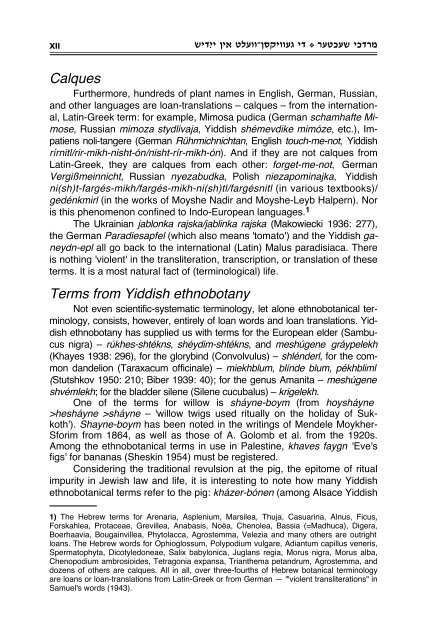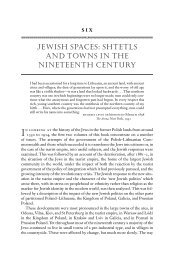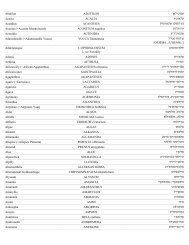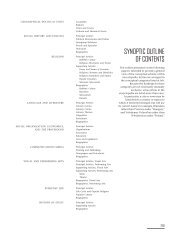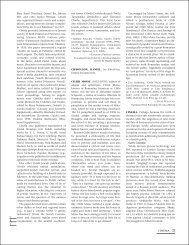t any plant names in Yiddish - YIVO Institute for Jewish Research
t any plant names in Yiddish - YIVO Institute for Jewish Research
t any plant names in Yiddish - YIVO Institute for Jewish Research
You also want an ePaper? Increase the reach of your titles
YUMPU automatically turns print PDFs into web optimized ePapers that Google loves.
XII<br />
˘È„”È Ôȇ ËÏÚÂÂ≠ÔÒ˜ÈÂÂÚ‚ È„ Ÿ ¯ÚËÎÚ˘ È΄¯Ó<br />
Calques<br />
Furthermore, hundreds of <strong>plant</strong> <strong>names</strong> <strong>in</strong> English, German, Russian,<br />
and other languages are loan-translations – calques – from the <strong>in</strong>ternational,<br />
Lat<strong>in</strong>-Greek term: <strong>for</strong> example, Mimosa pudica (German schamhafte Mimose,<br />
Russian mimoza stydlivaja, <strong>Yiddish</strong> shémevdike mimóze, etc.), Impatiens<br />
noli-tangere (German Rührmichnichtan, English touch-me-not, <strong>Yiddish</strong><br />
rírnitl/rir-mikh-nisht-ón/nisht-rír-mikh-ón). And if they are not calques from<br />
Lat<strong>in</strong>-Greek, they are calques from each other: <strong>for</strong>get-me-not, German<br />
Vergißme<strong>in</strong>nicht, Russian nyezabudka, Polish niezapom<strong>in</strong>ajka, <strong>Yiddish</strong><br />
ni(sh)t-fargés-mikh/fargés-mikh-ni(sh)tl/fargésnitl (<strong>in</strong> various textbooks)/<br />
gedénkmirl (<strong>in</strong> the works of Moyshe Nadir and Moyshe-Leyb Halpern). Nor<br />
is this phenomenon conf<strong>in</strong>ed to Indo-European languages. 1<br />
The Ukra<strong>in</strong>ian jablonka rajska/jabl<strong>in</strong>ka rajska (Makowiecki 1936: 277),<br />
the German Paradiesapfel (which also means 'tomato') and the <strong>Yiddish</strong> ganeydn-epl<br />
all go back to the <strong>in</strong>ternational (Lat<strong>in</strong>) Malus paradisiaca. There<br />
is noth<strong>in</strong>g 'violent' <strong>in</strong> the transliteration, transcription, or translation of these<br />
terms. It is a most natural fact of (term<strong>in</strong>ological) life.<br />
Terms from <strong>Yiddish</strong> ethnobot<strong>any</strong><br />
Not even scientific-systematic term<strong>in</strong>ology, let alone ethnobotanical term<strong>in</strong>ology,<br />
consists, however, entirely of loan words and loan translations. <strong>Yiddish</strong><br />
ethnobot<strong>any</strong> has supplied us with terms <strong>for</strong> the European elder (Sambucus<br />
nigra) – rúkhes-shtékns, shéydim-shtékns, and meshúgene gráypelekh<br />
(Khayes 1938: 296), <strong>for</strong> the gloryb<strong>in</strong>d (Convolvulus) – shlénderl, <strong>for</strong> the common<br />
dandelion (Taraxacum offic<strong>in</strong>ale) – miekhblum, blínde blum, pékhbliml<br />
(Stutshkov 1950: 210; Biber 1939: 40); <strong>for</strong> the genus Amanita – meshúgene<br />
shvémlekh; <strong>for</strong> the bladder silene (Silene cucubalus) – krigelekh.<br />
One of the terms <strong>for</strong> willow is sháyne-boym (from hoysháyne<br />
>hesháyne >sháyne – 'willow twigs used ritually on the holiday of Sukkoth').<br />
Shayne-boym has been noted <strong>in</strong> the writ<strong>in</strong>gs of Mendele Moykher-<br />
S<strong>for</strong>im from 1864, as well as those of A. Golomb et al. from the 1920s.<br />
Among the ethnobotanical terms <strong>in</strong> use <strong>in</strong> Palest<strong>in</strong>e, khaves faygn 'Eve's<br />
figs' <strong>for</strong> bananas (Shesk<strong>in</strong> 1954) must be registered.<br />
Consider<strong>in</strong>g the traditional revulsion at the pig, the epitome of ritual<br />
impurity <strong>in</strong> <strong>Jewish</strong> law and life, it is <strong>in</strong>terest<strong>in</strong>g to note how m<strong>any</strong> <strong>Yiddish</strong><br />
ethnobotanical terms refer to the pig: kházer-bónen (among Alsace <strong>Yiddish</strong><br />
1) The Hebrew terms <strong>for</strong> Arenaria, Asplenium, Marsilea, Thuja, Casuar<strong>in</strong>a, Alnus, Ficus,<br />
Forskahlea, Protaceae, Grevillea, Anabasis, Noëa, Chenolea, Bassia (=Madhuca), Digera,<br />
Boerhaavia, Bouga<strong>in</strong>villea, Phytolacca, Agrostemma, Velezia and m<strong>any</strong> others are outright<br />
loans. The Hebrew words <strong>for</strong> Ophioglossum, Polypodium vulgare, Adiantum capillus veneris,<br />
Spermatophyta, Dicotyledoneae, Salix babylonica, Juglans regia, Morus nigra, Morus alba,<br />
Chenopodium ambrosioides, Tetragonia expansa, Trianthema petandrum, Agrostemma, and<br />
dozens of others are calques. All <strong>in</strong> all, over three-fourths of Hebrew botanical term<strong>in</strong>ology<br />
are loans or loan-translations from Lat<strong>in</strong>-Greek or from German — '"violent transliterations" <strong>in</strong><br />
Samuel's words (1943).


